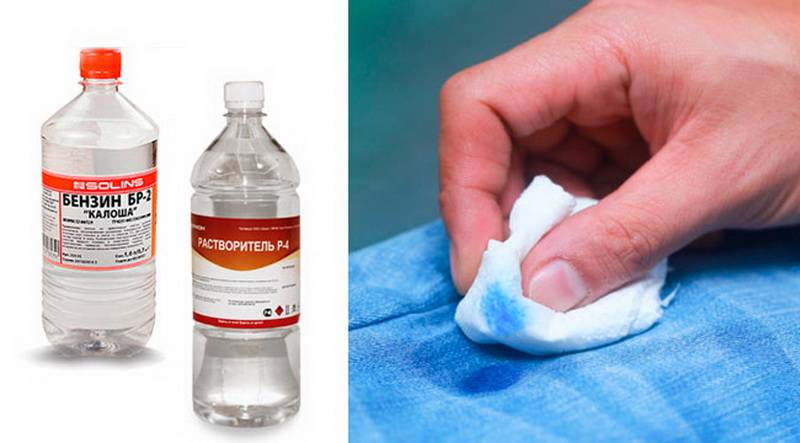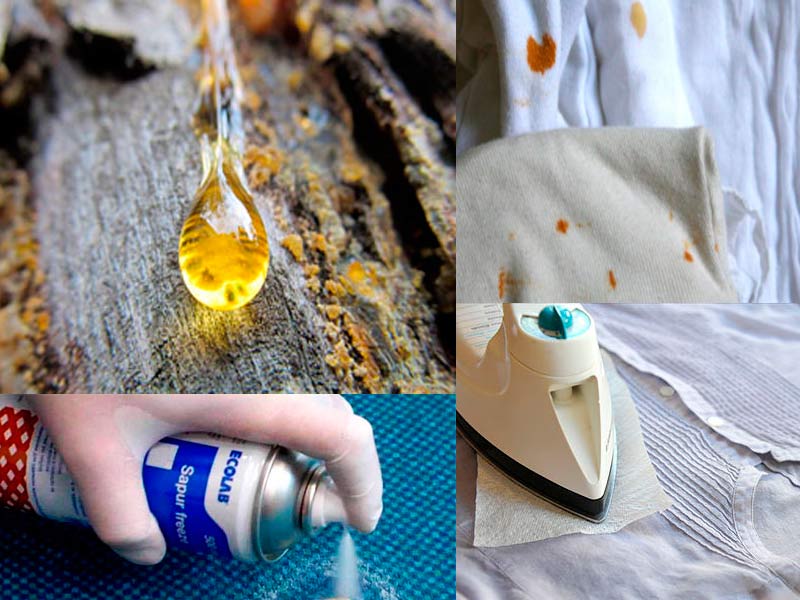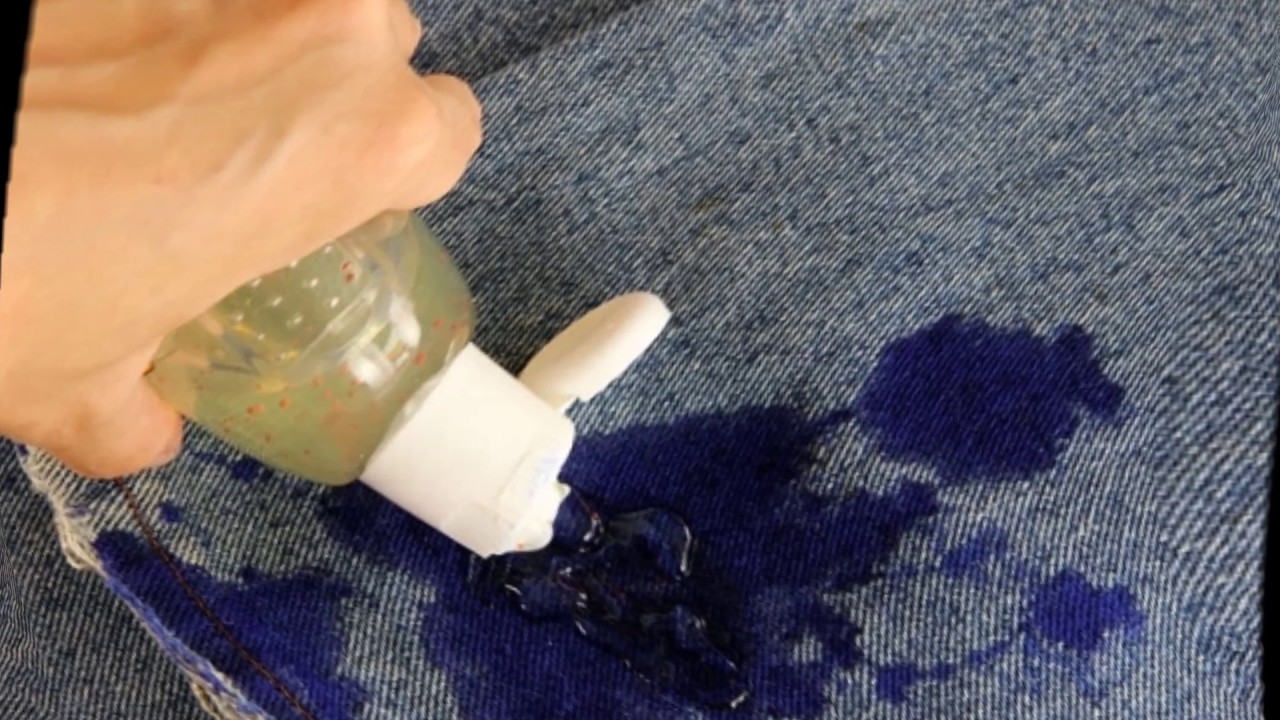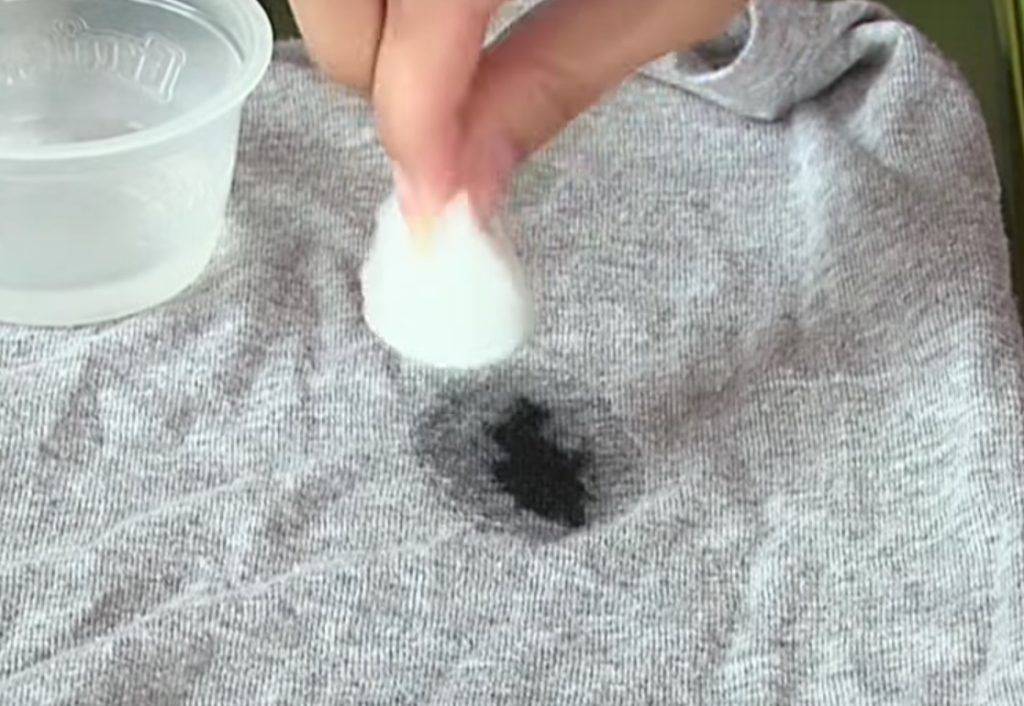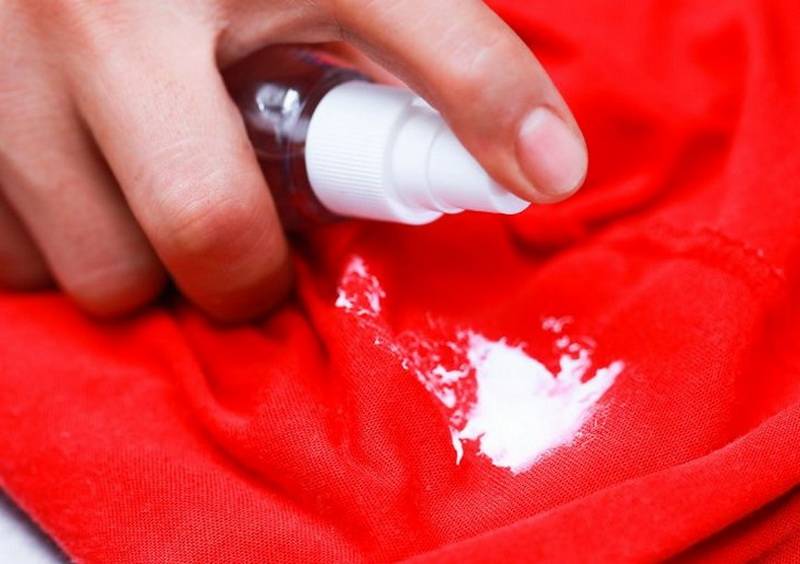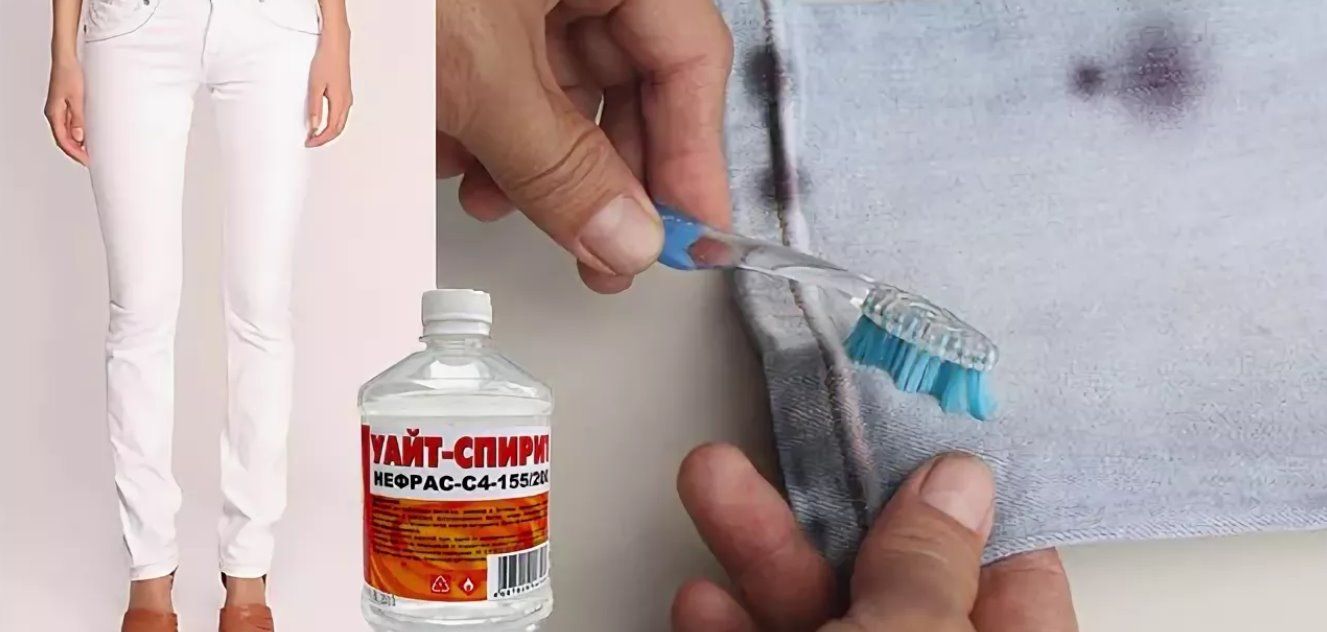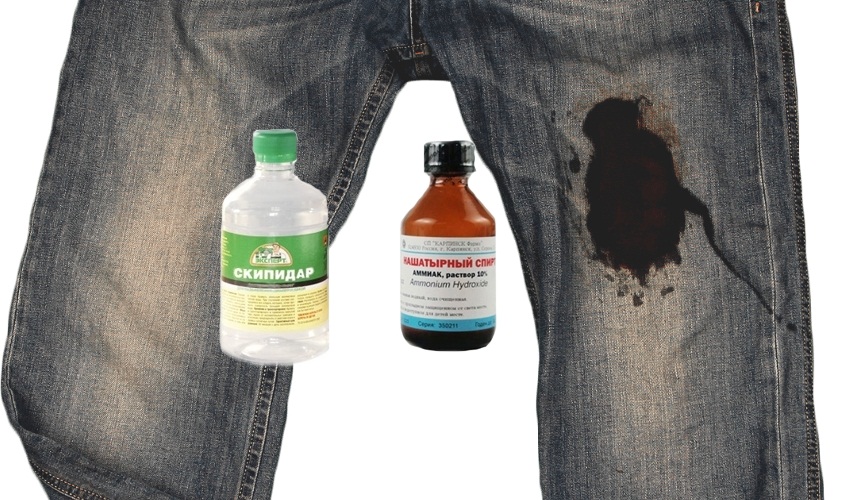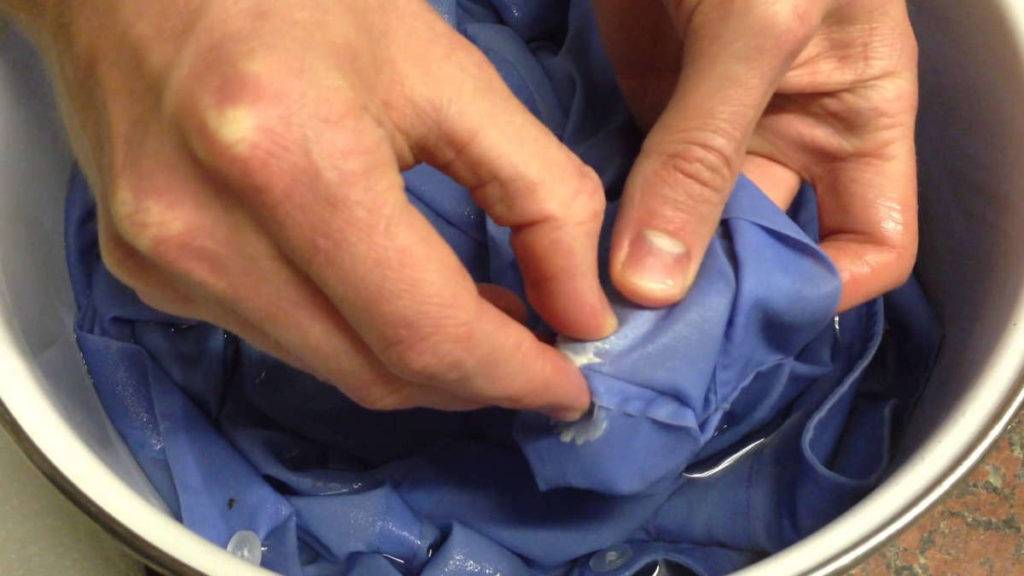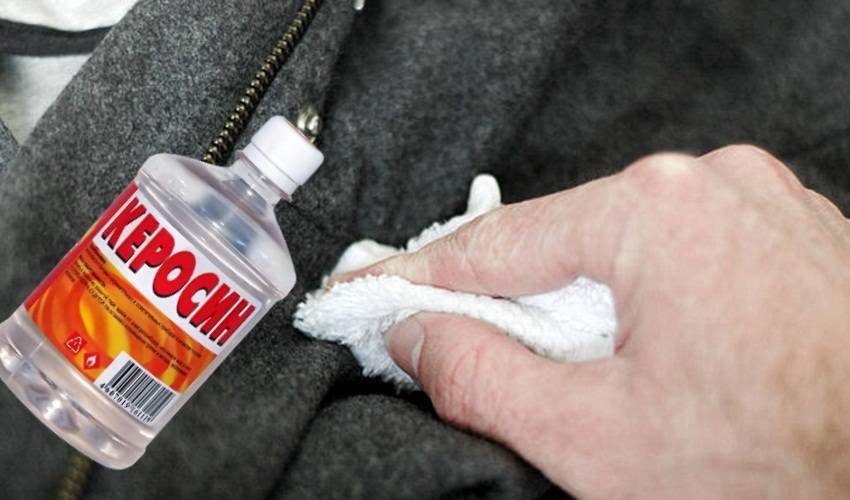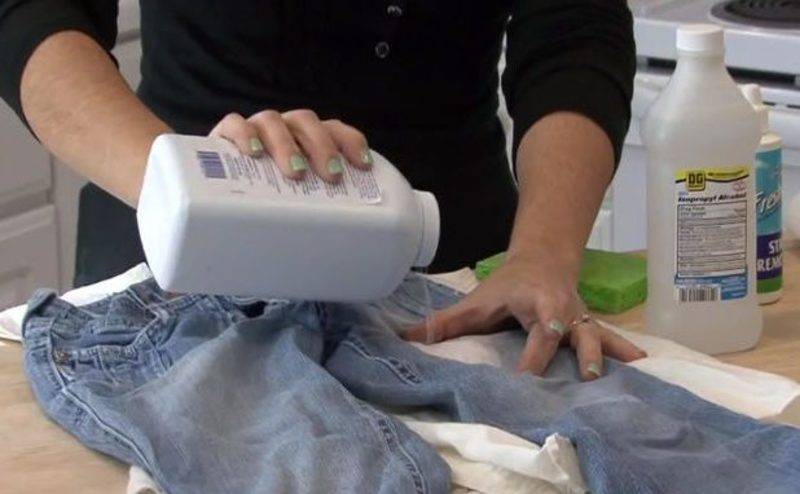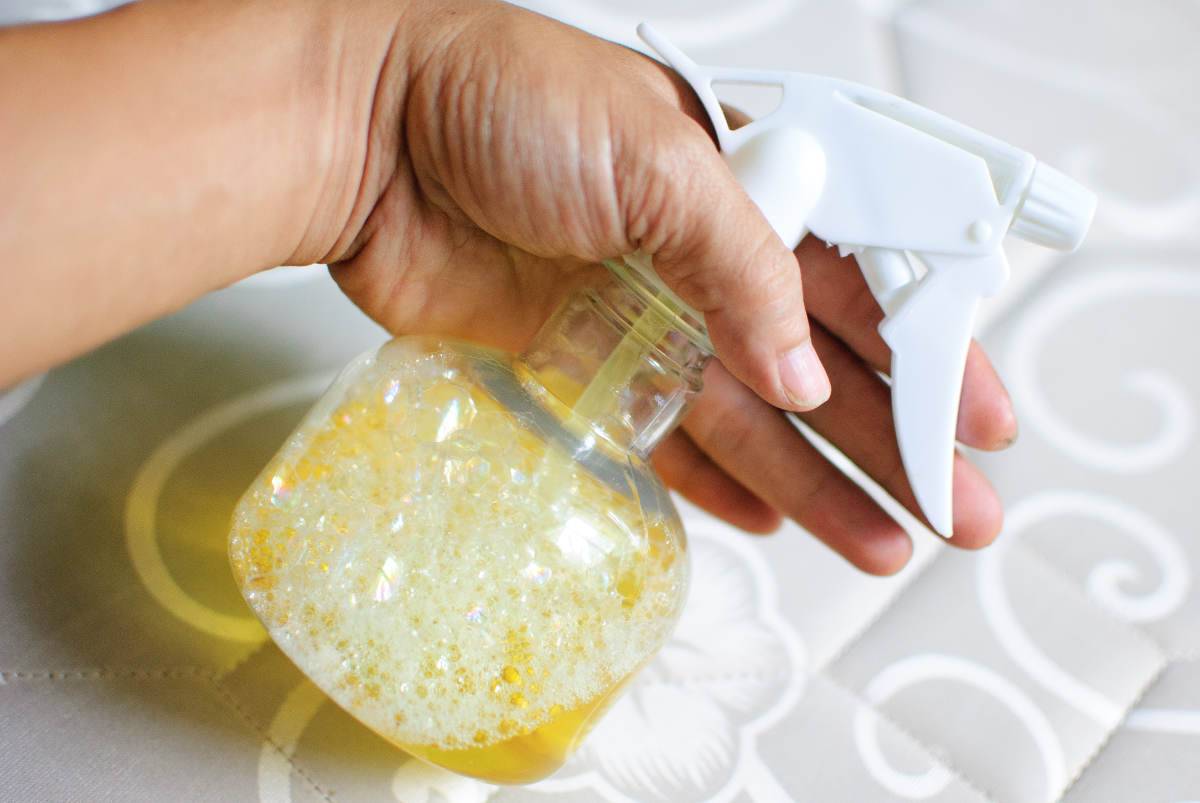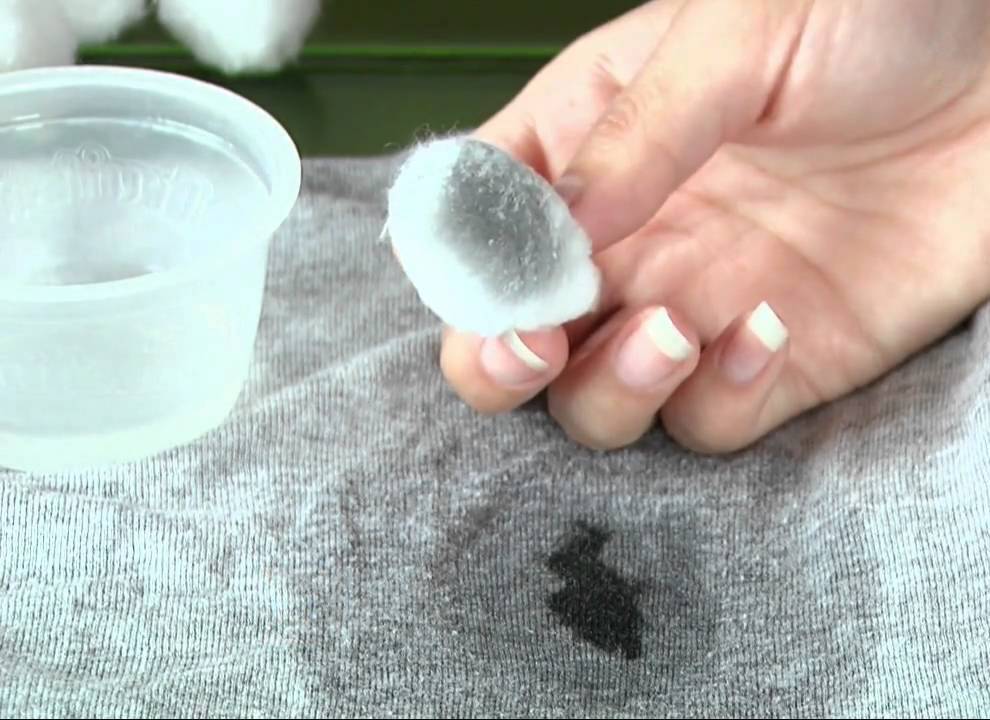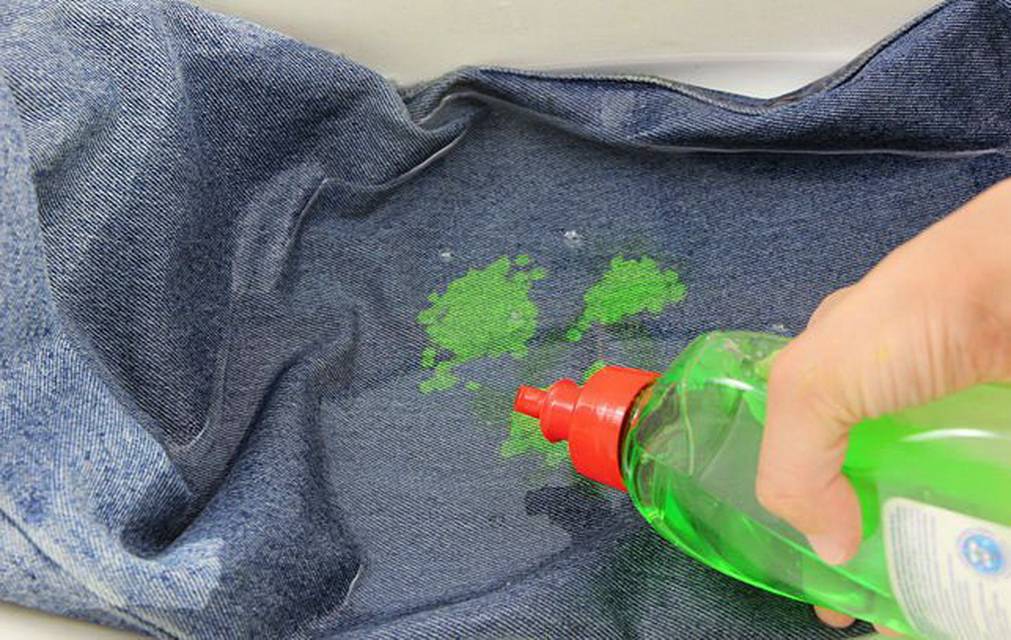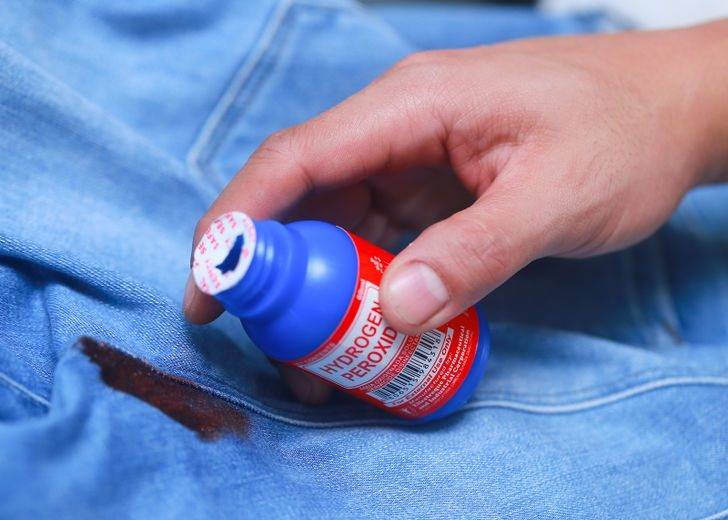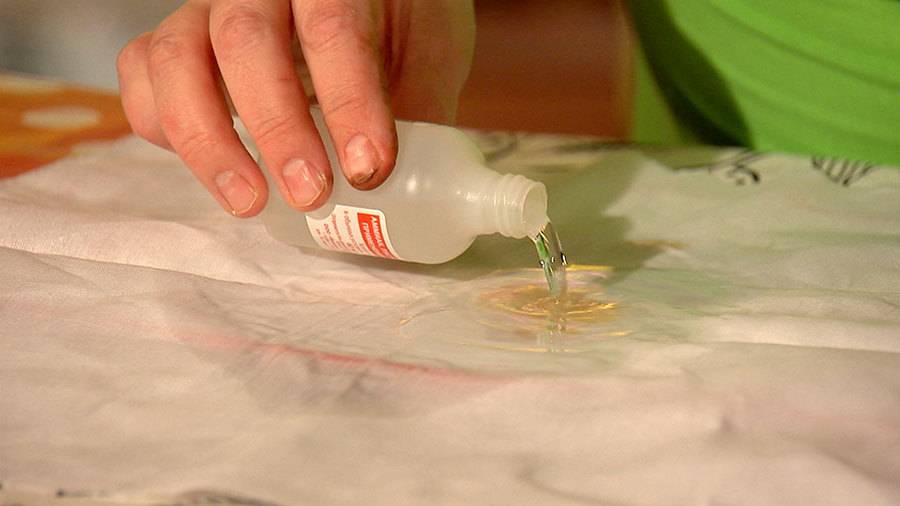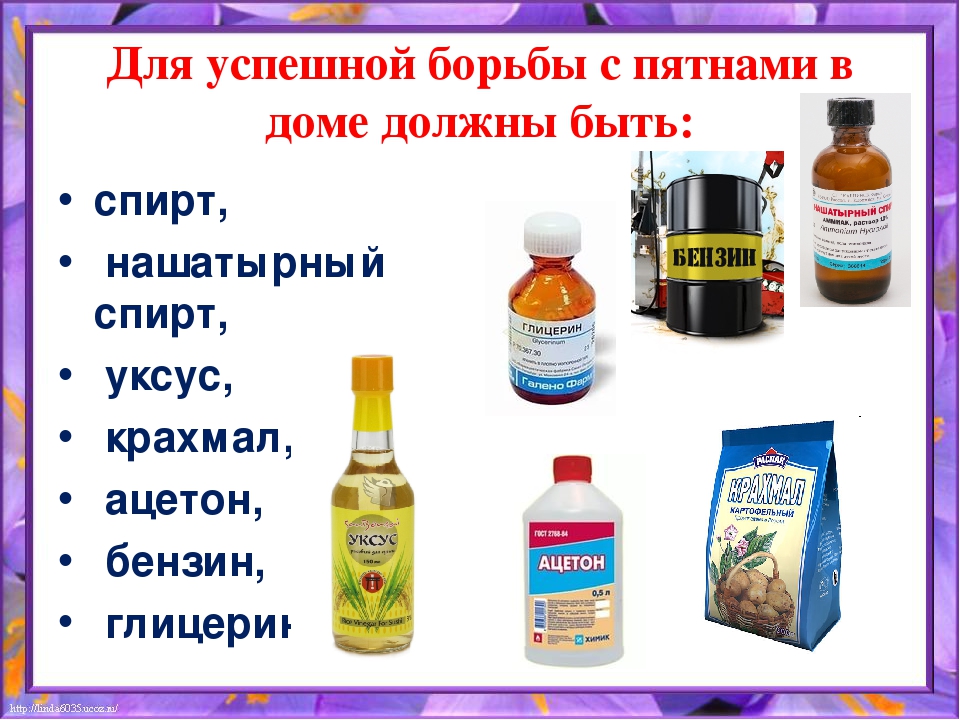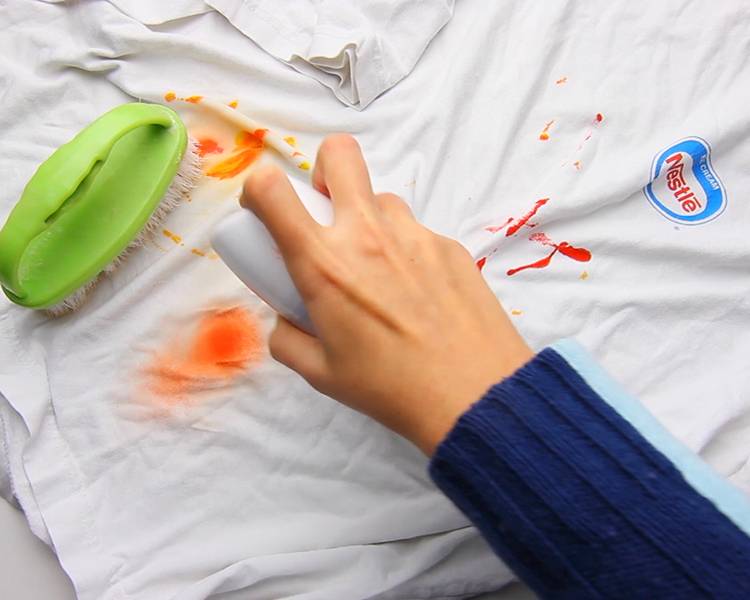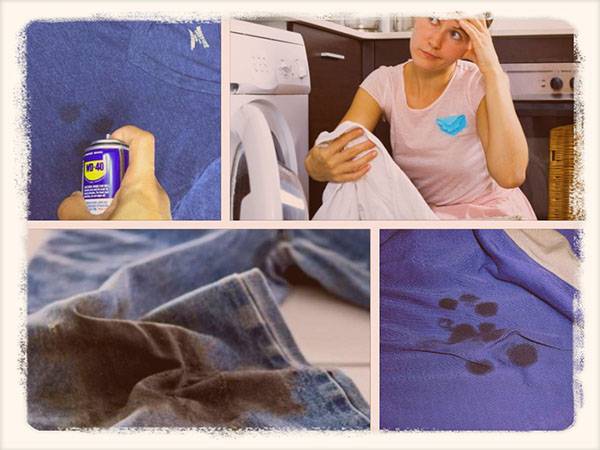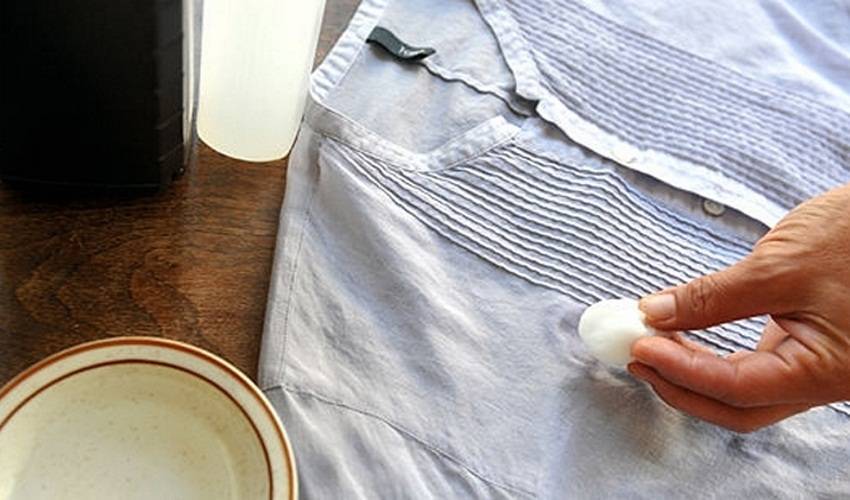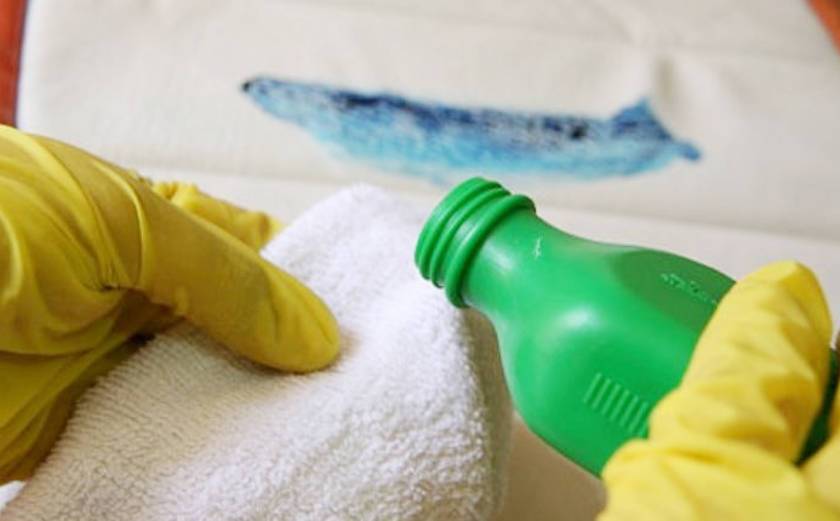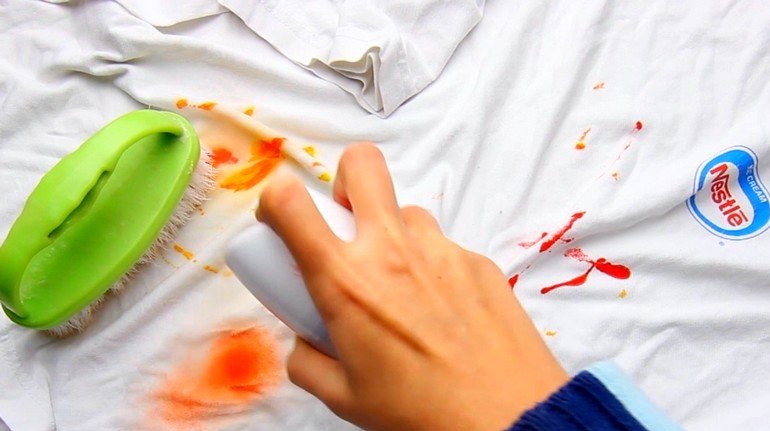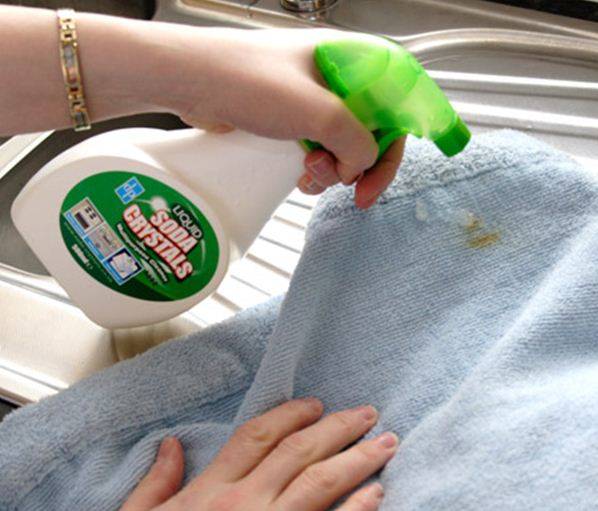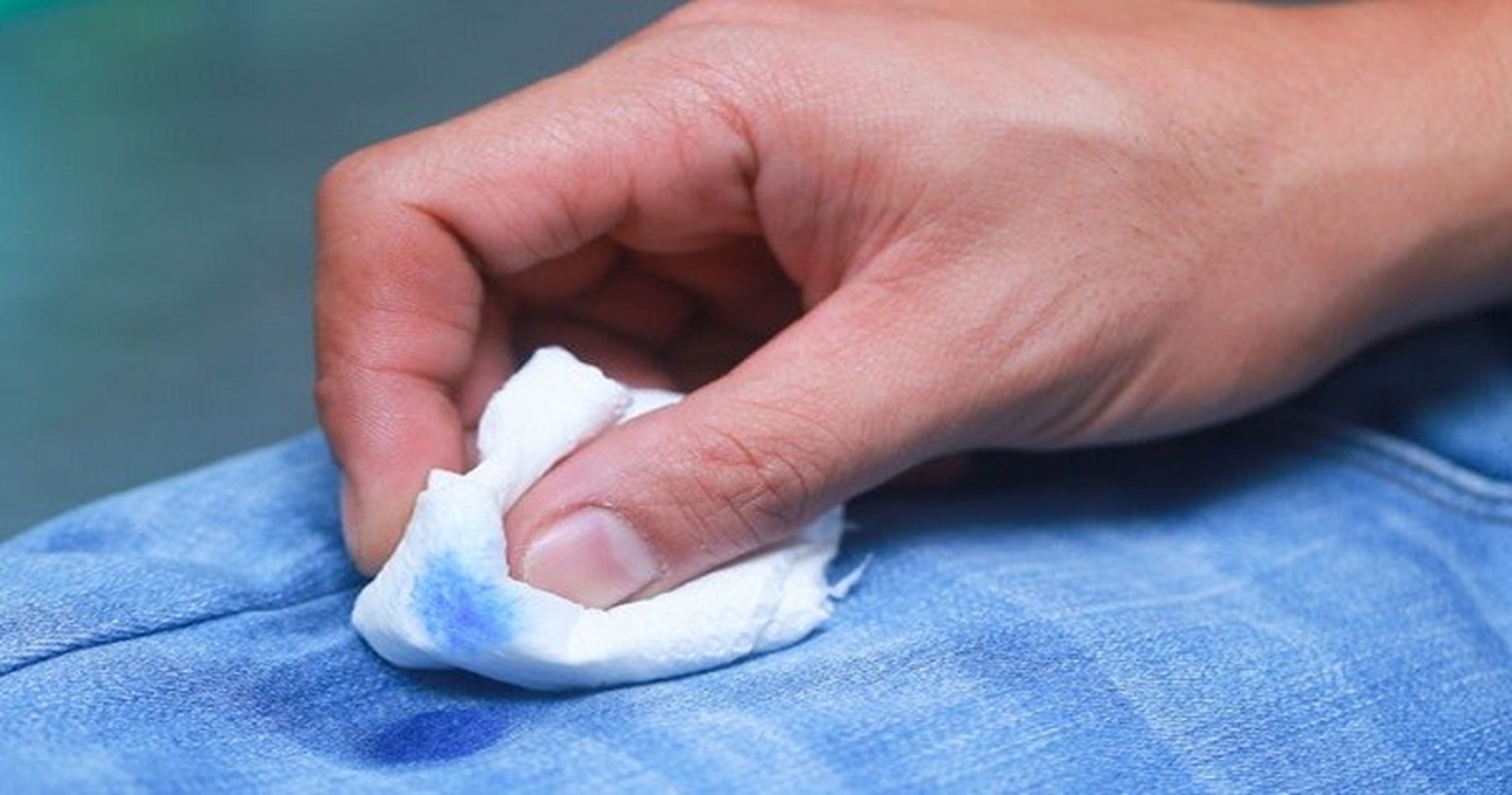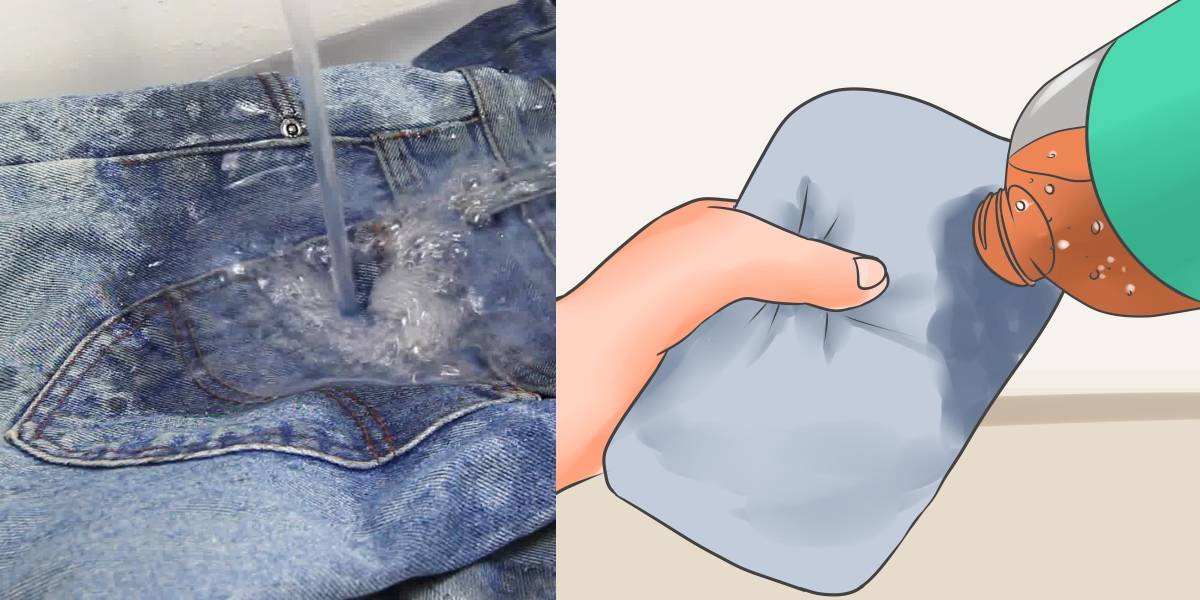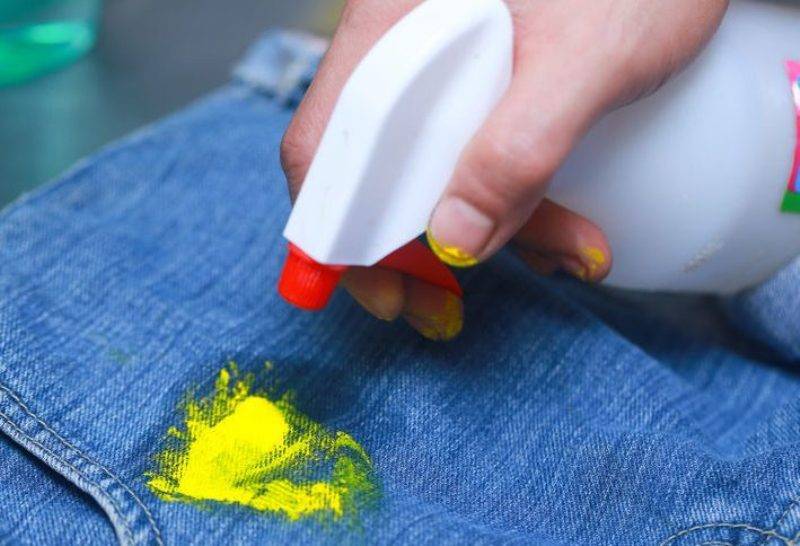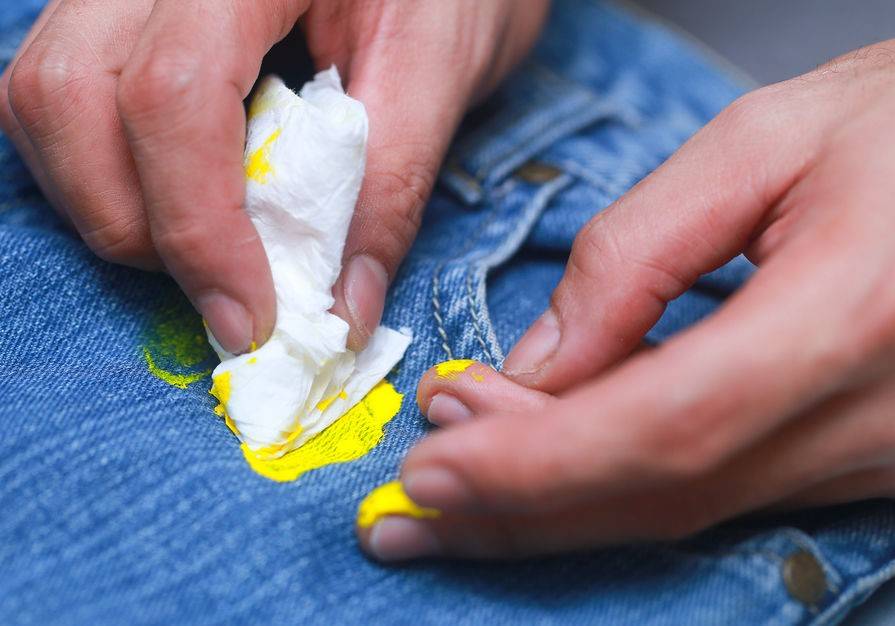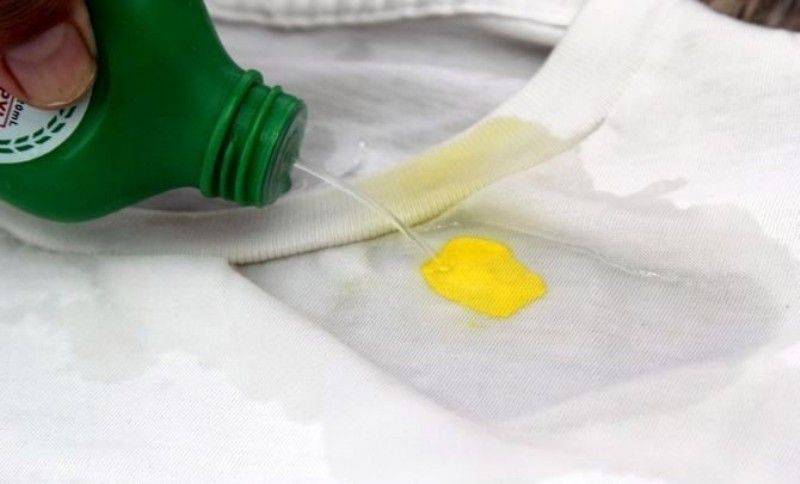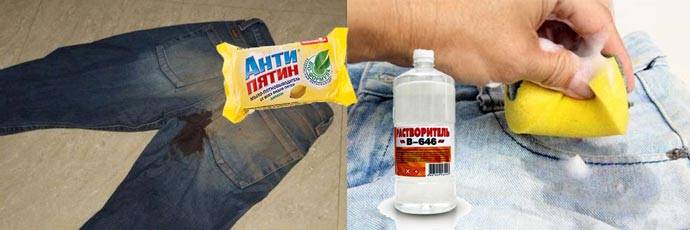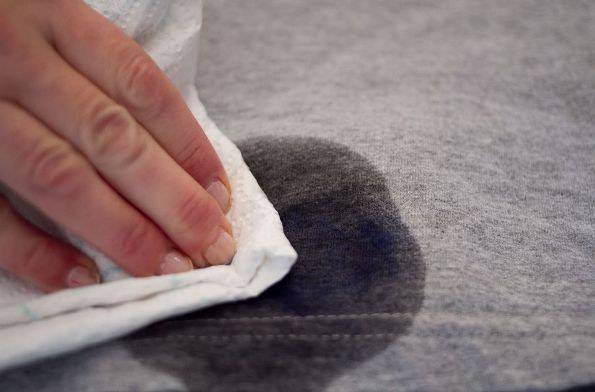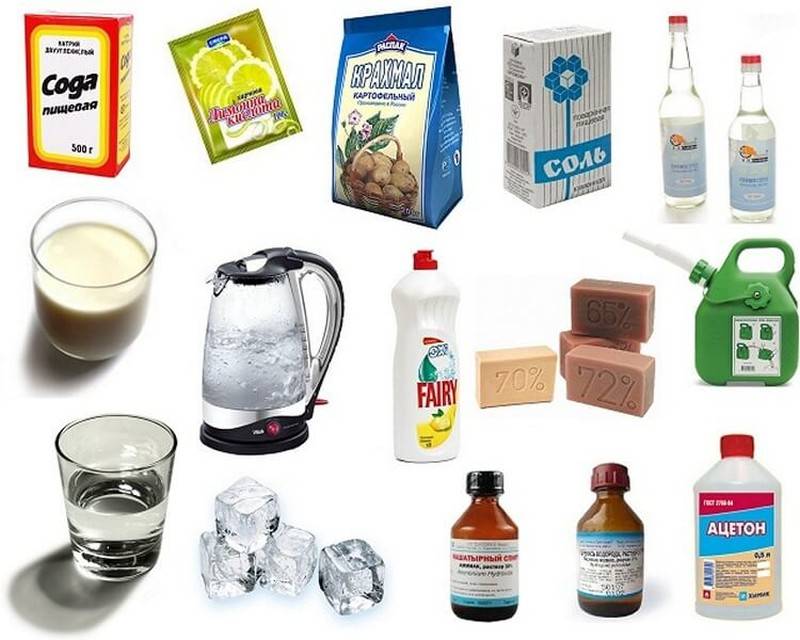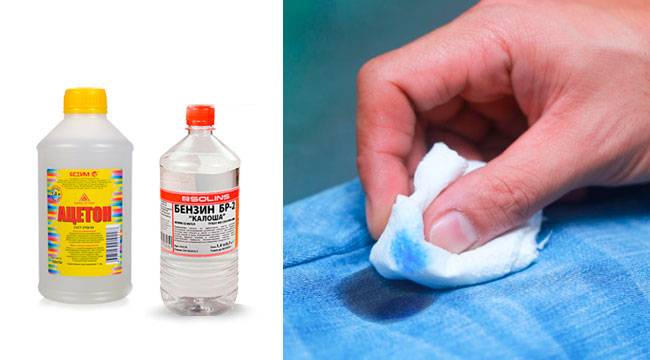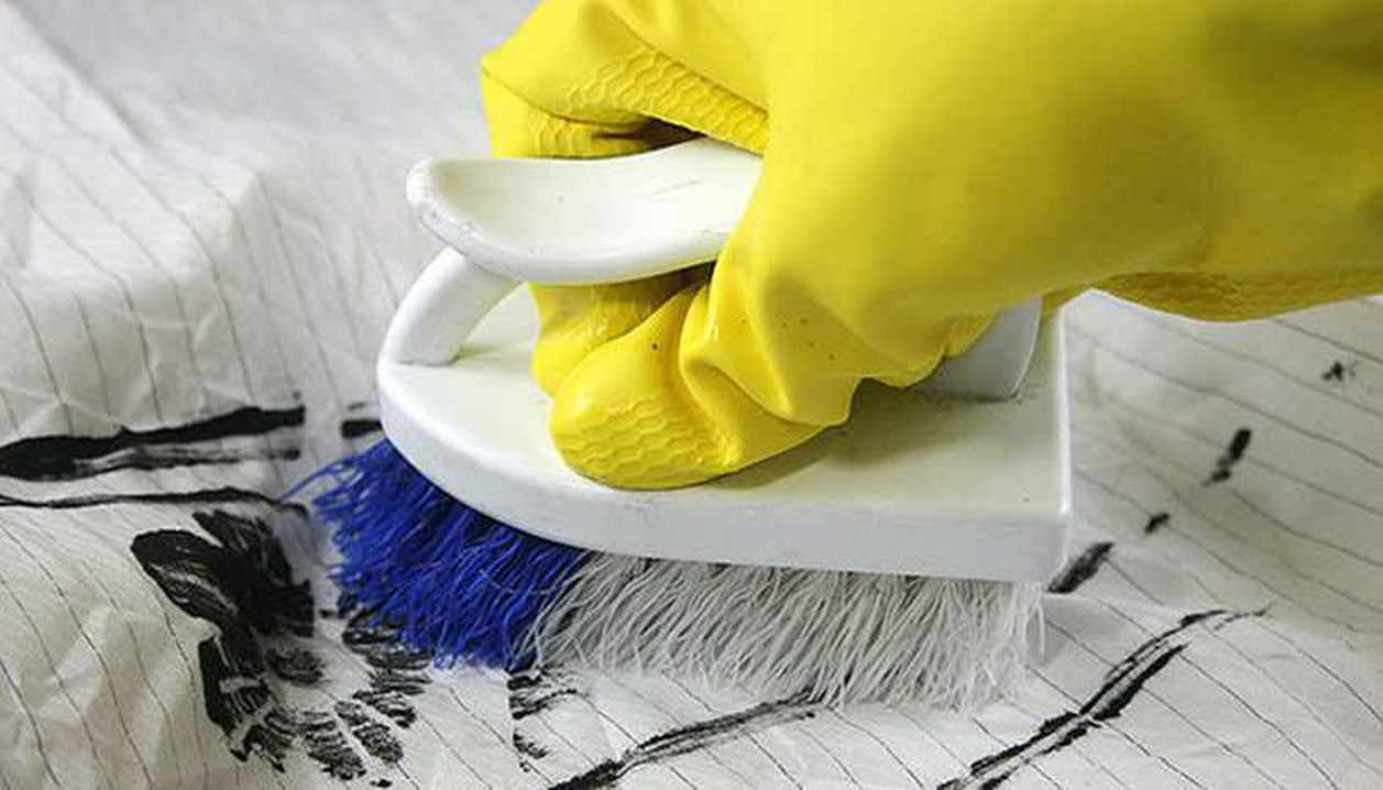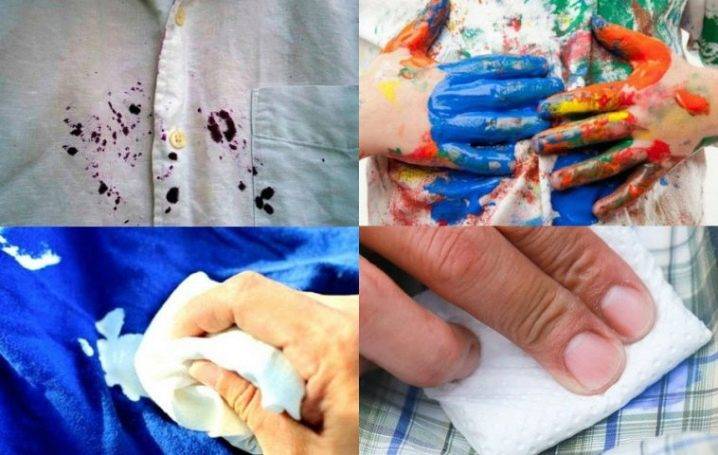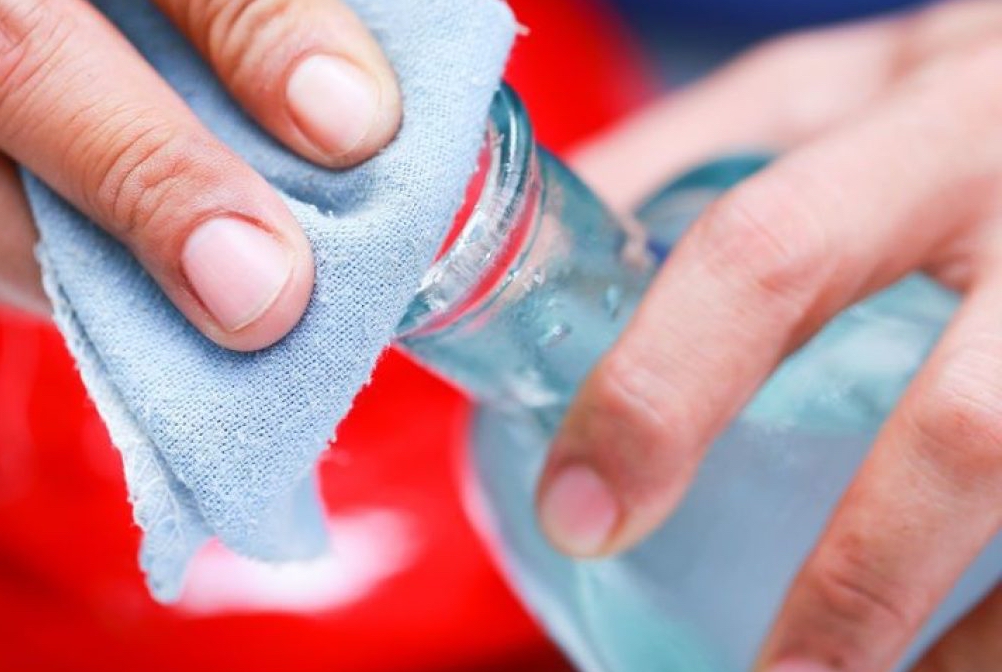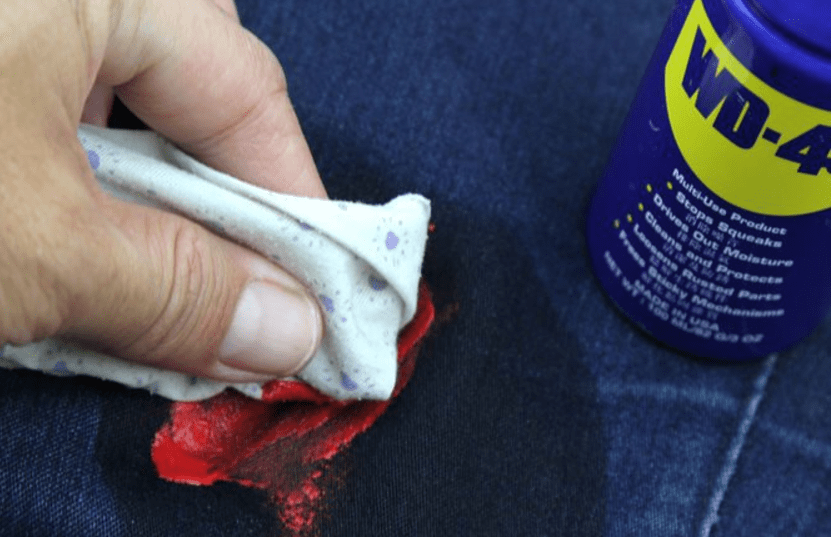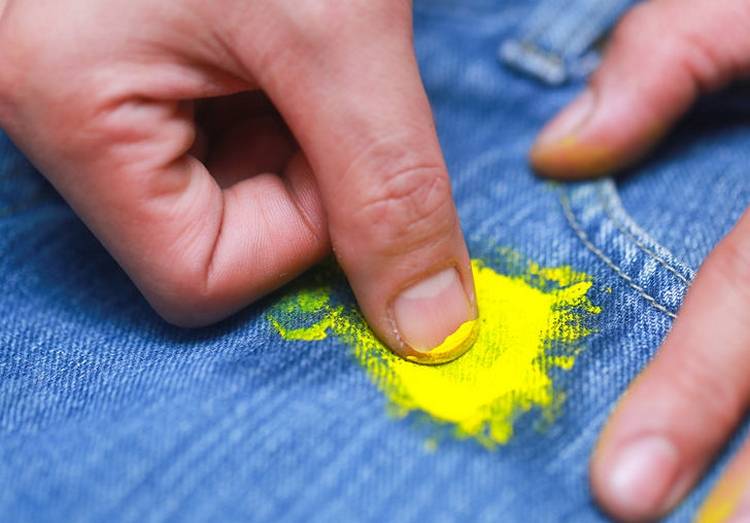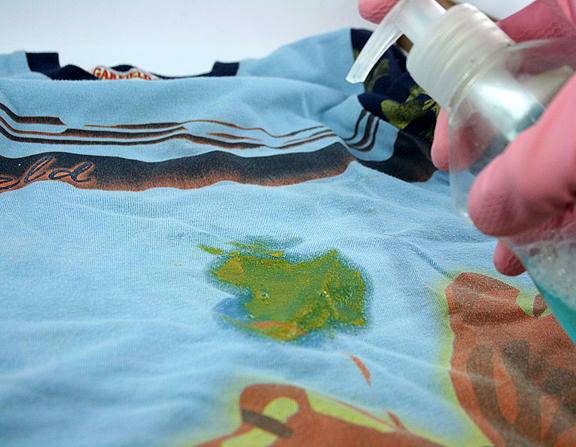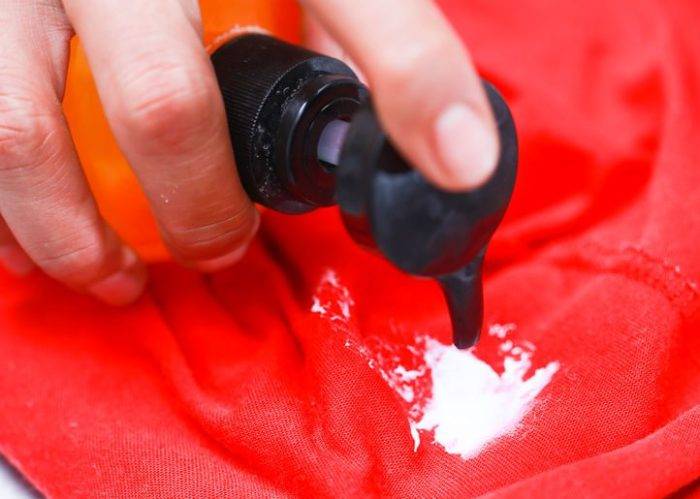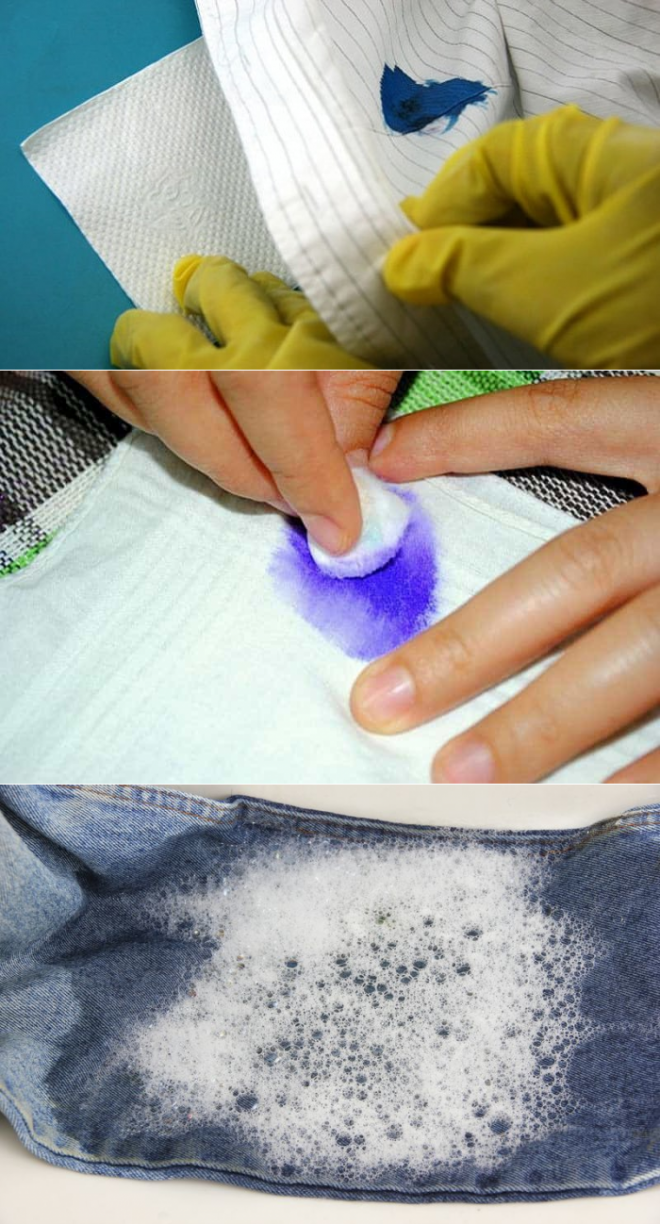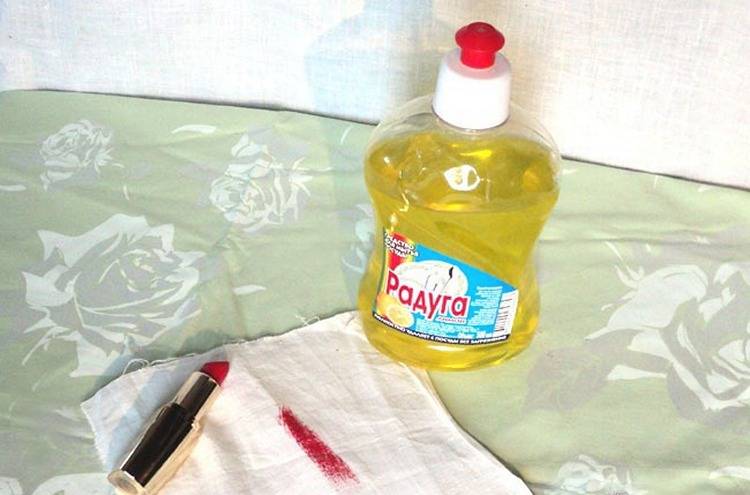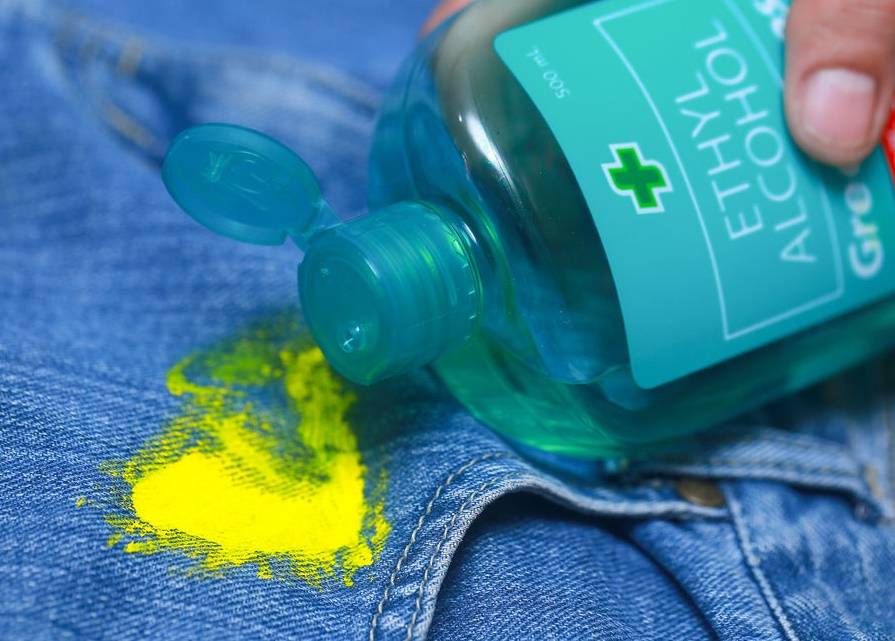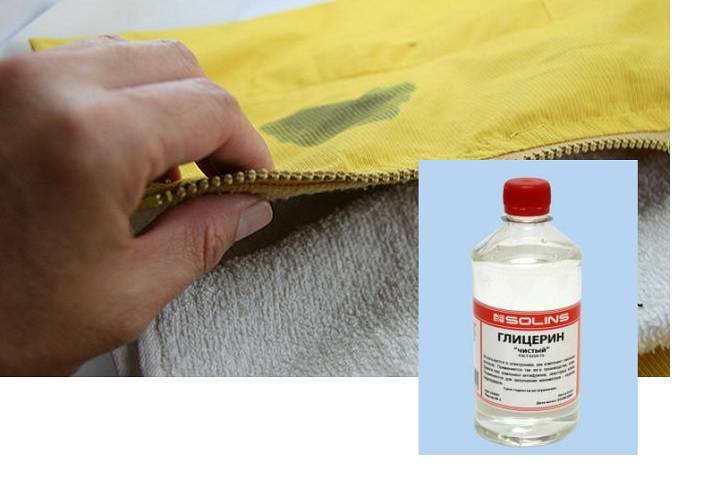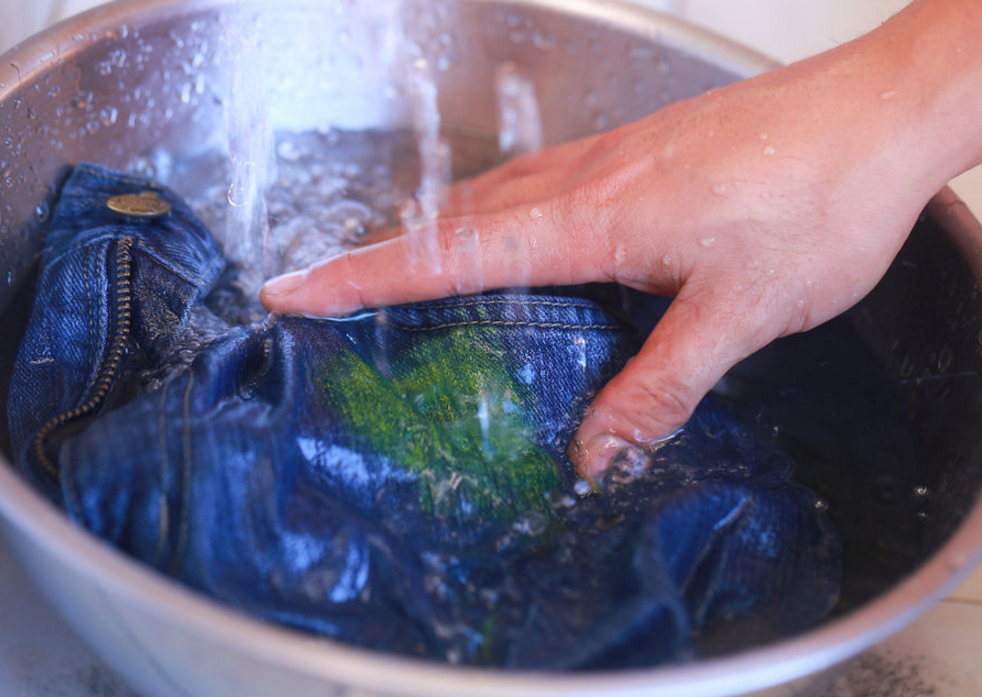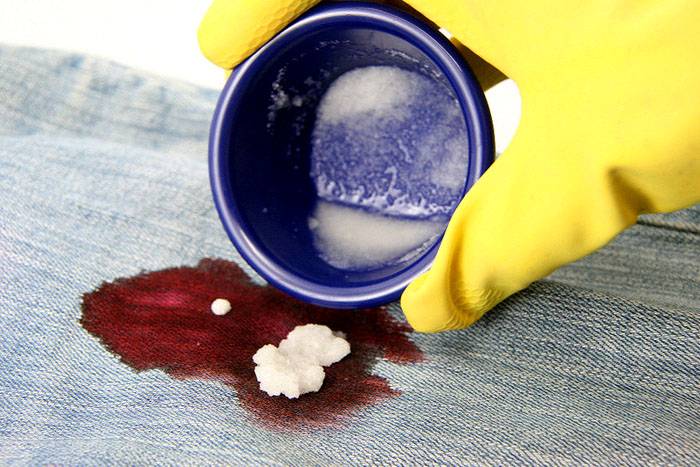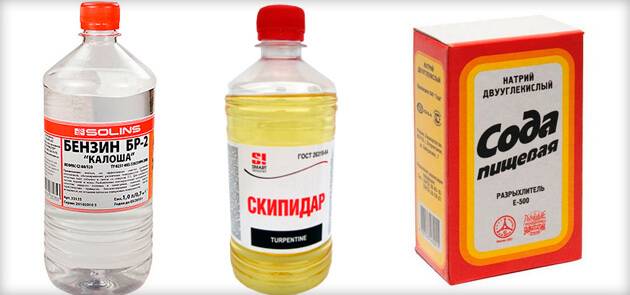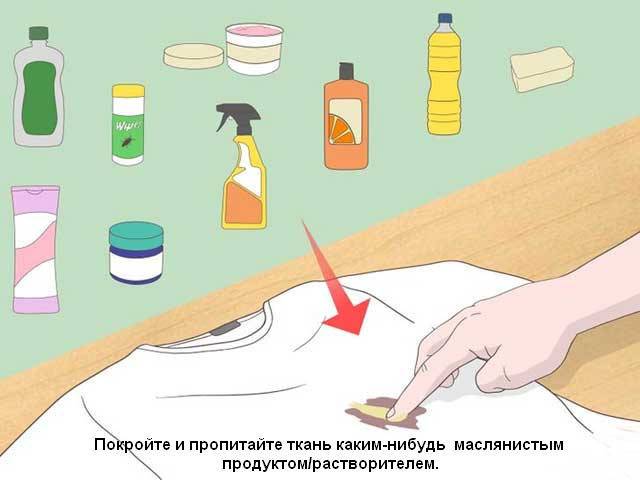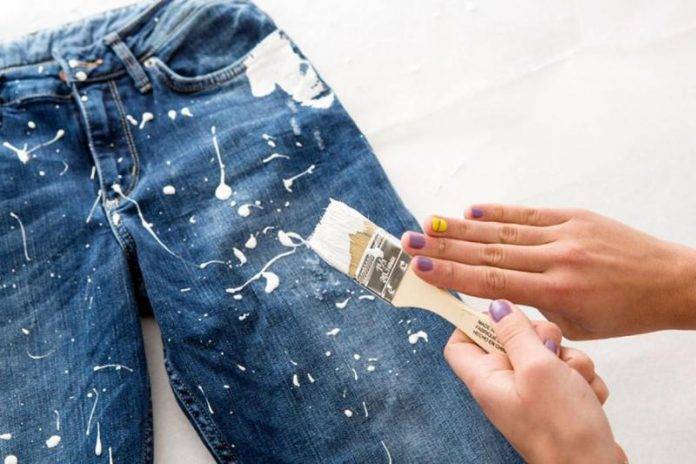Folk remedies
The composition of stain removers is very aggressive and can damage or ruin things. First, it is better to try to remove stains with gentle folk and cosmetic products.
Laundry soap
You can wash the tinting agent with brown 72% soap. The high alkali content makes it possible to break down fats and coloring pigments.
To remove the cream from the fabric, follow the sequence:
- Wet the stained area or product completely.
- Rub with soap and leave for 30 minutes.
- Rub gently using a brush.
- Wait a few minutes.
- Rinse and wash with detergent.
If the stain is old, make a soapy solution and soak for 1 - 2 hours. Lightly rub off dirt, wash.
Make-up remover
There are no caustic components in the makeup liquid for cleaning the face, so it is suitable for thin delicate fabrics. The liquid will dissolve grease and dyes.
If the foundation did not have time to dry, you can wipe it off in the following way:
- Wet a cotton pad. Use a cotton swab for small stains.
- Wipe clean with gentle movements. Do not rub in a chaotic manner.
- Remove residues with a damp cloth, wash.
If the dirt is already old and dry, you need to apply the product, wait about an hour and wash.
Dishwashing liquid
Effectively dissolves oily foundation. It is convenient to use the tool to remove the tone from the jacket.
To remove makeup marks, you should:
- Wet clothes and pour gel.
- Gently rub the fabric, leave for half an hour. If the stain is old, increase the time to 2 hours. Sprinkle with salt or baking soda to enhance the effect.
- Rinse. Repeat the steps if a trace remains.
Wet wipes
A small stain from a foundation can be washed off with damp wipes.
Do not press, otherwise the foundation will penetrate deep into the fibers. When the cloth becomes dirty, replace it with a clean one.
If a yellow mark remains on the clothes, use laundry soap to wash the product.
Petrol
You will need refined gasoline. The liquid has a pronounced odor, processing should be carried out in a well-ventilated area.
Cleaning procedure:
- Moisten 2 cotton swabs with flammable liquid.
- Attach from the back and front, fix the position.
- Wash the item with conditioner. Repeat the procedure if necessary.
After processing, a yellow stain from gasoline may remain, which is removed with a vinegar solution.
Starch
Remove the foundation using potato starch. Recommended for items that cannot be washed frequently, such as woolen items. The starch cleanses the fiber by absorbing grease and dyes.
To clean your clothes, do the following:
- Sprinkle the stained area with starch, wait 10-15 minutes.
- When it has absorbed the dirt, peel off and sprinkle again. Leave on for 10 minutes.
- Gently rub the area with a soft brush.
- Shake off the starch. Repeat the manipulation if necessary.
The method is effective for fresh dirt.
Salmon + soda
Things soiled with foundation can be washed off using ammonia and soda.
Requires 10% ammonia. It has whitening properties and is therefore not recommended for colored items. The baking soda absorbs the greasy base of the cream.
Cleaning principle:
- Soak a piece of cloth or cotton wool with alcohol.
- Rub a little, attach to the track. Wait 10 minutes.
- Remove the cotton swab. Sprinkle baking soda over the area.
- Shake off the soda. Using a brush, rub the damaged area.
- Wash the product.
Alcohol or vodka
Alcohol-free dye-free liquids will help clean outerwear, fur products. It is better to do this immediately after the cream hits the surface, otherwise it will be difficult to cope with the pollution.
To remove the foundation, you need to moisten a cotton swab with alcohol and wipe the damaged area. After such cleaning with alcohol, it is not necessary to wash clothes or rinse with water.
The best ways to get rid of
During the existence of watercolor paint, through trial and error, many ways have been created to get it out of clothes. Some recipes guarantee 100% results, therefore they are the most common. If, after working with paint, clothes get dirty, use one of the proposed methods.
"Antipyatin"
You can find a bar of soap at any household chemical store. It is also replaced with ordinary laundry soap. The stains are lathered and left for 1 hour. After that they are easily washed off.

Baby washing powder
It would seem that this tool is not able to wash away watercolor stains, but it is not. Powder for baby clothes effectively copes with this task. Repeated cleaning may be required for a satisfactory result.
Stain remover or bleach
Means containing natural ingredients have proven themselves well. After treating the stain with a product, it is allowed to be absorbed. This takes no more than 15 minutes. Then go to the standard wash.
Hot vinegar
The solution is heated and applied to the stain with a cotton pad. After careful processing, the item is washed in warm water. Vinegar, especially hot vinegar, is not suitable for delicate fabrics.
Soda and hydrogen peroxide solution
You will need the following ingredients:
- 100 ml of peroxide;
- 100 g of soda;
- 100 ml boiling water.

The components are mixed until smooth. The composition is applied to dirty spots with rubbing movements. After processing, the thing is erased.
Dry fragments
The method is more suitable for dense fabrics from which special clothes for artists are sewn. Also applicable to jeans and other similar materials. A dense layer of paint is left to dry completely. After that, it is scraped off with scissors, the blunt side of a knife or other convenient device.
Glycerol
You will need pure glycerin purchased from a drugstore. The product is applied to problem areas for 15-20 minutes. During this time, the substance penetrates into the paint, softening its particles.
Then they move on to the second stage of cleaning. 2 tsp glycerin is mixed with 2 tsp. alcohol. With the resulting mixture, dirty places are re-processed.
White cloth

The advantage of white fabrics is that they are easier to clean. Contamination from the dye is removed in any way you like, given below.
Chlorine bleach
Stable dye should readily succumb to chlorine bleach. How to wash “blots” from clothes with bleach? To do this, soak the laundry for 15-30 minutes in water with the addition of "Whiteness". With dried paint from 2 to 12 hours. Then rub with your hands, rinse in clean water, and machine wash. "Whiteness" will make the fabric snow-white and add freshness.
It is good to use this bleach to remove traces of red wine or blood from white things.
Glycerin, salt and vinegar
Such familiar products as salt, vinegar and pharmacy glycerin cope well with unnecessary stains. It is worth noting that these cleaners are recommended for thick materials, as thin fabrics may not withstand their aggressive effects.
- Fill in the dirt with a little glycerin.
- After five minutes, drop a couple of drops of salt dissolved in water.
- Add vinegar after another five minutes.
The reaction will follow immediately and the speck will dissolve. For the best effect, add a couple of drops of ammonia, rinse and then wash.
Soda and vinegar
The interaction of vinegar and baking soda breaks down the colorful pigment.For this, a small amount of the bite is mixed with 1 tablespoon of vinegar. After cleansing, rinse and wash as usual.
First aid for items with fresh paint stains
The sooner a stain is found, the more likely it is to remove it completely. You shouldn't take the first tool you come across and use it. Any substance must be applied to the fabric from the inside out, placing the paper to the front. Napkins or paper towels are perfect for this. This will prevent ink from penetrating deep into the fabric. The stain should be removed from the edges towards the center to prevent spreading and dripping.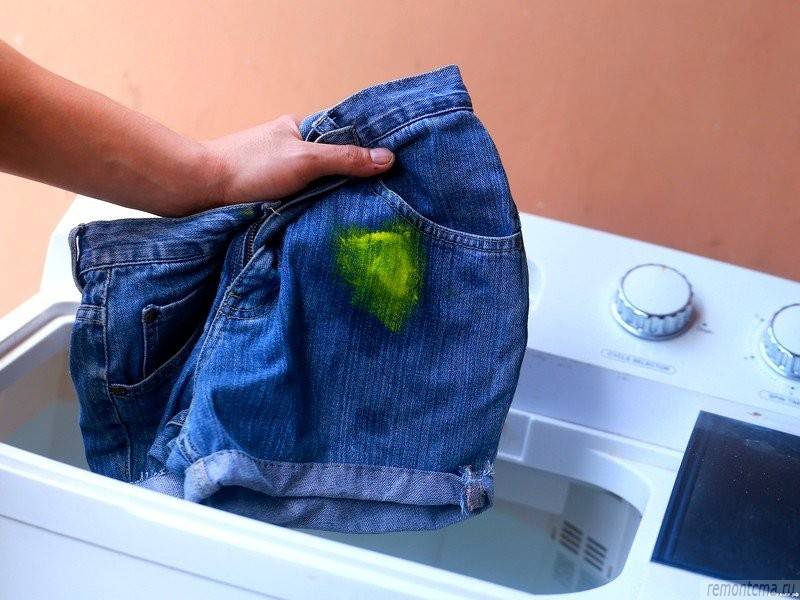
To select the best way to get rid of the stain, you should set the type of dye. Types of dyes that can get on clothes:
- watercolor;
- gouache;
- acrylic;
- water-based;
- oil;
- enameled;
- hair dye.
Do you erase by hand?
Oh yes no
Having determined the type of substance, you can begin the procedure to remove the stain
It is important to follow the correct sequence of actions to ensure maximum results:
- Preparing a home work surface. Often, hazardous solutions are required to remove paint from things: acetone, kerosene, gasoline, white spirit and others. It is necessary to follow certain safety rules: act in a well-ventilated area, for example, on a balcony or loggia.
- The place for work should be covered with oilcloth or cling film. It is advisable to put a white dense fabric on top.
- The processing of the material should not be carried out on surfaces that have been painted (a layer of paint may come off them). Parquet and laminate are also excluded: stains remain on these materials.
- Before removing a trace of paint, test the selected product on a corner of the garment and evaluate the reaction of the fabric.
Hair dye removal methods
Fresh dirt is easier to wipe off. Rinse it intensively in cold water and wash as usual with the addition of detergent.
Hairspray is great for fighting fresh stains. Spray varnish on the surface, rub and wash in warm water and detergent. The method is widely known in beauty salons.
Hydrogen peroxide will get rid of the long-standing speck, which is poured directly onto the pollution and left so for up to half an hour. Then they wash in the usual way.
An excellent remedy for colored fabrics is 9% table vinegar. It is safe for the color of the fabric and imparts richness. The vinegar is left for 20 minutes on the desired area, and then you need to rinse and wash the thing.
Solvents can be used on bright fabrics: gasoline, acetone, kerosene, white spirit. They are considered more potent than vinegar or hydrogen peroxide. Apply the solvent on a cotton pad to the contaminated area.
If such an annoying nuisance occurs on a white fabric, the use of aggressive agents will be much more expedient. Antipyatin soap is an effective solution. Rinse the soapy area of the fabric under running water and wash with conditioner after 20 minutes.
A remedy will help to get rid of the stained area from the snow-white cotton fabric: 10% ammonia solution (1 tablespoon), hydrogen peroxide (1 tablespoon) and 1 glass of water are mixed, warmed up a little and applied to the pollution with a cotton pad. After 10 minutes, wash the garment with fabric softener.
When using oxygen bleach, pay attention to the rules of use set forth in the instructions for it. There will be no trace of the stain, and the brightness and quality of the picture will remain unchanged
If a monochromatic white thing is dirty, soaking in cool water with the addition of "Whiteness" is suitable. Soaking time is about 2 hours.
Sunflower oil is also used to remove stains. A small amount is applied to the contaminated area and wiped off with a cotton ball.Once the stains have disappeared, apply a dish soap (this will help remove the remaining oil) and wash.
Ink features
The colorant used in printer ink comes in two flavors:
- pigment;
- synthetic dye.
Synthetically, the dye is water-based. For laser printers, a special coloring powder is used - toner. Inkjet printers use from 8 to 14 components in addition to solvent and colorant.
High quality ink bases its action on the fact that it penetrates deep into the paper, producing quality prints. Once in the skin, it likewise penetrates deeper layers.
Water based
If you get water-based paint on your hands, in most cases it is enough to wash your hands with soap and cold water to remove it. If the contamination is recent, your hands will be clean. If the paint stains are old, paint may still remain on your hands after cleaning.
Oil paint
If the utilities have not attached an information sign "Caution, painted!" You can try to remove completely fresh dirt with liquid soap.
The cloth is poured abundantly with detergent, a little water is added. Rub the stain with a napkin until it is completely removed.
Solvents
If paint or enamel has managed to penetrate between the fibers, it is removed with acetone, white spirit, turpentine, refined gasoline (you can buy it at a hardware store). A cotton swab or cloth is moistened with liquid and the contaminated area is cleaned.
The traces remaining after the manipulations are removed with ammonia. The second option is to iron the fabric with a warm iron through a paper backing.
Everything at hand
It happens that the problem of how to remove oil-based paint from clothes at home is solved with the help of available products without the use of solvents.
- Butter and powder. For cleaning colored items, a mixture of softened oil and washing powder (1: 1) is prepared. Apply gruel to the stain, rub it in, wash the fabric after 2-3 minutes.
- Vegetable oil. It is used as a common solvent - trying not to "stretch" the paint stain onto clean areas.
- Soda and laundry soap. If a question arises of how to remove paint from white cotton clothes, use the "hot" cleaning method. Stir a spoonful of soda and grated laundry soap (200 g) in a liter of water. The solution is brought to a boil, the product is immersed in it for 10 seconds, after which it is washed in the usual way.
- Dishwashing liquid. A little warmed up water is added to it, the mixture is spread over the fabric, after a few hours it is cleaned with a brush and washed off with clean water.
- Alcohol and soap. Suitable for fine silk fabrics. It is rubbed with dry laundry soap and then cleaned with warm alcohol. Finally, a hot wash is performed.
- Alcohol and salt. A nylon or nylon fabric is first treated with heated alcohol. Dissolved paint is washed off with salt water.
Tips & Tricks
If the above methods do not bring the desired result, then there are the following recommendations:
- If the chemical odor does not disappear for a long time (more than a month), then it is best to completely replace the coating. Leaving smelling linoleum is dangerous, as it affects the condition of residents.
- To speed up the result, an air cleaner is installed. Additionally, an air freshener is used, which is able to work automatically.
- A quartz lamp will help clear the room of harmful substances. It not only removes chemical compounds, but also helps speed up the process of removing odors.
- The use of lemon helps to eliminate the aroma in a short time if it is applied directly to the slices themselves.
How strong linoleum will smell depends on what material it is made of. Less synthetic materials emit the scent of flaxseed oil and do not cause serious discomfort. This smell is eliminated on its own within a week. If the humidity in the room is increased, then the specified period increases.
PVC, which is often used in floor coverings, also emits an odor. As a rule, it lasts up to three weeks. If the material is laid face down before laying and left for a couple of days, this will help to ventilate the room as soon as possible.
Share link:
Read more about “eliminating” gouache stains from clothes
Vinegar, salt and ammonia
The mixture is prepared in the following proportions: salt - 30 grams, vinegar 9% - 60 milliliters, ammonia - 30 milliliters. The prepared gruel is spread over the contaminated area and left for 10 minutes. After, it is removed with a brush, and the thing is washed with powder.
Acetone
It is also quite harsh, not suitable for delicate fabrics. You can take acetone, both in pure form, and nail polish remover. Soak a cotton pad or swab and wipe the paint from the edges of the dirt to the center. You can first pour acetone, and then rub. At the end, as always, the usual wash of the entire product.
White Spirit
The contaminated area is wiped off with white spirit until the paint disappears. Substances similar in action: kerosene, acetone, gasoline.
Soap
If suddenly, after dyeing the hair, a trace remains on things, then it should be rubbed with laundry soap and left for 30-60 minutes, and then washed in a washing machine or by hand.
There are many ways to remove paint stains from clothing. We recommend: do not panic, quickly navigate and determine what type of fabric and paint you have, as well as the size of the disaster. It is advisable to use sparing methods at first, and according to the result produced, it is determined with further actions.
All the above methods of removing paint are very carefully applied when working with fabrics such as silk, viscose, wool, fine synthetics.
How to remove fresh paint stains
How to wash paint from clothes? Proven methods:
butter (butter and vegetable). The old-fashioned method works flawlessly on any type of material. The main thing: do not hesitate to apply a natural product
Moisten a cotton swab with an oily liquid, carefully wipe off the top layer of paint from the edges to the center, take a new disc, apply oil again, rub the contaminated area well. The paint mark disappears quickly enough
Washing with laundry soap or powder will help to finally put the thing in order. It is necessary to take exactly butter, and not margarine or a product based on vegetable fats: cheap products of poor quality have a different composition, they cope worse with pollution;
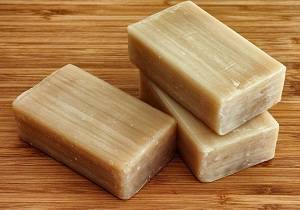
laundry soap. Carefully pick up the top coat of paint if thick enough. Beat in a strong foam, apply to the stain, and set aside for a few minutes. At this time, prepare a soapy solution, wash the dirty area well in a basin. Be sure to wash with your hands, do not use a clothes or an old toothbrush: stiff bristles rub particles of synthetic substance into the fibers, it will be very difficult to remove dirt. It is important to use only high-quality laundry soap (you need to find the inscription "72%" on the bar);
a mixture of borax and kefir. Sodium borate is sold at a hardware store. Many housewives keep this product at home. To remove traces of paint, you need to carefully remove most of the mass with a cotton sponge, apply a mixture of 30 ml of vinegar 9%, 55 g of borax and 75 ml of kefir. Apply a homemade stain remover (always without lumps) on the outside of the stain, wait until the mass is dry. Cover the treated area, carry out the same operation on the other side. After a third of an hour, clean the stain with a toothbrush, wash with laundry soap;
accenton. The product is suitable for light-colored clothing. The first step is to remove excess paint, the second is to apply nail polish remover or acetone to the problem area. Do not rub the trail of synthetic dyes strongly so that the stain does not creep;
petrol. Great for removing dirt from clothing. Purified gasoline (this is the product that will be needed to remove stains of various kinds, not from the gas tank) apply to a cotton pad, moisten a fresh trace of the dye, gently wipe the contaminated area. You should not use a purified type of petroleum products to remove the dye composition from synthetic fabrics.
Note! Traces and splashes from watercolors are easier to remove than from other types of coloring compositions. The water-based product lags well behind the fibers after soaking the problem area in clean warm water. After 10-15 minutes, you need to thoroughly wash the item with your hands using powder or laundry soap.
Fresh paint washes better
It is very unpleasant when any paint gets on the clothes. Knowing how to wipe paint off your clothes is more likely to get rid of the stain completely.
If your clothes are soiled with paint, it is best to start cleaning and washing right away. Until the paint has dried, it is much easier to wipe it off. This applies to all types of paint.
Fresh paint can be blotted off immediately with a dry paper or cloth. In this case, the spot should not spread in breadth.
If the paint is already dry, you need to separate it from the fabric with a knife or spoon.
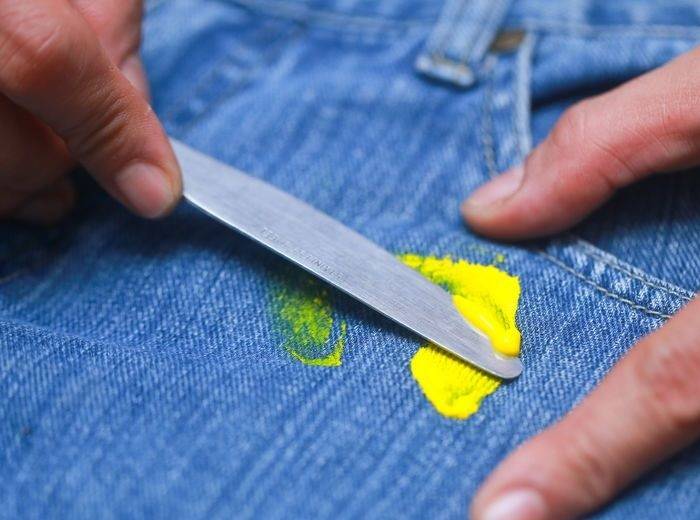
Remaining paint can be wiped off with isopropyl alcohol. Isopropyl alcohol is a good solvent and is often used in the home. It can wipe off dried paint or ink stains on most natural fabrics, including cotton and silk.
The use of turpentine as an anti-pollutant
Turpentine is used to remove oil paints from all fabrics, but it is most often used when it comes to delicate items. This is due to the fact that this product does not harm tissue. It needs to be used two or three times to achieve the desired effect. The procedure for removing oil stains with turpentine consists of several stages.
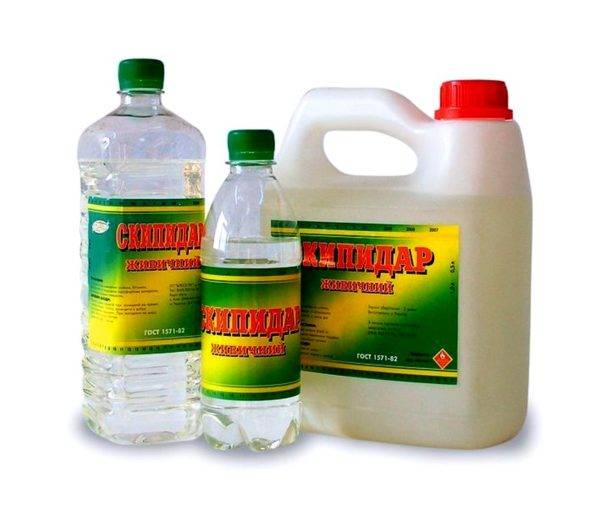 Turpentine can be used to remove oil paint stains from clothing.
Turpentine can be used to remove oil paint stains from clothing.
First, the thing should be cleaned with a brush or simply shaken out the dust. After that, use a cosmetic disc (or cloth) dipped in turpentine to wipe the oil paint stain with a rotating motion. The stain must be treated on both sides. It is not necessary to press hard so that the paint does not penetrate deeply into the fabric. This stage of processing the fabric with turpentine can be seen in the photo below.
After the thing is completely saturated with turpentine, you need to wait 10 to 15 minutes, then place a couple of paper napkins on both sides of the product (front and back), and press firmly with your hands.
The next step is to re-coat the stain with turpentine and leave the thing for 1 hour. Next, wipe the problem area with a toothbrush, and send the thing to the washing machine. If the oil stain has not been completely removed, then you need to moisten it with water, sprinkle with talcum powder, and place soft paper on both sides. Then you should treat the place of contamination with an iron, and then wash the thing in the washing machine, adding an air conditioner.
How to wipe paint from clothes at home
Before thinking about how to remove paint from clothes at home, you need to establish the type of paint. In this article, we'll look at ways to deal with oil, water, and hair dyes. The formulations of paints are different, so the means for removing them will also vary.
Removing oil paint
The surest way to deal with oil pollution is to use vegetable oil. Apply oil to the stain and walk over with a soft cloth or cotton wool.If the stain is difficult to come off, leave the product on the stain for thirty minutes. Then carefully remove the remaining oil. A standard dish gel is suitable for this.
Laundry soap is another way to remove this type of paint. However, its effectiveness is visible only on fresh spots. Laundry soap is usually used in combination with alcohol. In this case, the soap and alcohol are left on the stain for ten minutes. Then they are sent to the washing machine.
Ammonia and a salt water wash will help get rid of paint that has gotten onto synthetic fabrics.
Refined gasoline, white alcohol, thinner and kerosene can also be good helpers in this matter. It is necessary to use these funds as follows:
- place the substance on the stain and leave to soak for about fifteen minutes;
- wash off the remaining solvent with laundry soap;
- if the stain is fairly stubborn, use a commercially available oxygenated stain remover.
Dried stains could be a big problem if it weren't for turpentine. It softens dry paint perfectly. Regular baking soda with the addition of a few drops of water will help remove paint and product residues. This mixture must be gently rubbed into the stain.
An effective remedy for removing old oil stains is a mixture of alcohol, gasoline and the same life-saving turpentine. Dip a cotton pad into the resulting solution and start removing the stain. Frequent cotton wool changes will allow you to quickly achieve the desired result.
Warmed glycerin or acetone-free nail polish remover will help keep the colored fabric in its original form.
Be careful not to use acetone to remove stains, it not only discolours the fabric paint, but also destroys the fibers of the fabric.
Removal of acrylic and water-based paints
Acrylic and water-based paints are based on aqueous solutions. Fresh, they are easily washed off with plain water with the addition of powder and with the participation of a brush. However, dried paint does not come off so easily and the question arises again: how to wipe paint off clothes at home?
In this case, the use of alcohol is also suitable. Apply it to a soft cloth and wipe the dirt off. The stain should come off quickly and without any problems.
Alternatively, you can use soaking. You will need a solution of 2 tablespoons of rock salt and the same amount of vinegar in two glasses of warm water.
How to get rid of dried stains
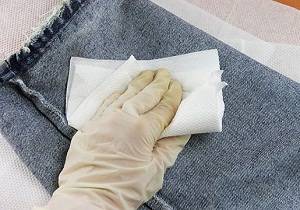
The result of exposure to a contaminated area does not always meet expectations, but you can try to get rid of old traces of pigment on jeans or a shirt. Lightweight items made from fine fabrics are more likely to have to be disposed of or put on rags. The second option for dealing with paint on delicate materials is to go to dry cleaning.
Proven funds:
- a mixture of salt and alcohol. The composition is suitable for removing dried water emulsion. First, you need to lay out the thing on a flat surface, sprinkle abundantly with salt, pour over with alcohol, and put the product aside for an hour. It remains to soak the dried peel of alcohol and salt, rinse, thoroughly erase the area where there were traces of pigment;
- laundry soap. If no more than two days have passed since the thing was dirty, then ordinary laundry soap can be used. To remove older stains, you need a stronger product, such as gasoline. Proceed as in the case of fresh stains, but soak in a strong soapy solution for 2 hours;
- turpentine. Suitable for removing traces of pigment from delicate materials such as silk. If the fabric is light, then stains may remain not only from the paint, but also from the natural "stain remover". When processing linen, wool, cotton fabric, the result is often not satisfied with the hostess.How to proceed: remove dust from the item (shake off the product), wet a cotton swab, treat the stain with turpentine on both sides, wait 10 minutes. When applying the natural composition, do not rub the material too much. After the specified time has elapsed, remove the softened mass using napkins, attaching a paper base on both sides. Moisten the rest of the paint with turpentine a second time, wait about 50 minutes, repeat the procedure. If the pigment particles do not lag behind well, then you can sprinkle talcum powder or baby powder on the contaminated area, put a sheet of copier paper on top, move it with a hot iron, iron it several times until the talcum powder absorbs most of the paint. At the end of processing, wash the item well.
If the paint gets on a white sheet or a light linen or cotton towel, you can boil the product in a solution of a chlorine-containing agent
It is important not to overdo it so that the fabric does not become too soft and loose, prone to rapid abrasion. To prepare the composition, mix 80 ml of Whiteness or Perrox with 6 liters of hot water
During boiling, it is imperative to press down on the product so that the contaminated place is always in the solution. After the procedure, place things in the washing machine, select a mode for very dirty laundry, pour bleach into the container, wash. While drying, cover sheets or towels with oilcloth or hang in the second / third row so that the direct rays of the sun do not fall directly on the material.
Paint stains are persistent, difficult to remove, especially if several days or weeks have passed since the moment of staining. How to remove stains from the coloring pigment? Available home remedies can be used
Care must be taken, especially when handling white and delicate fabrics. If in doubt, it is advisable to contact dry cleaning professionals so that after unsuccessful experiments you do not have to put your favorite dress or almost new trousers on rags.
Paint stains are one of the most annoying types of stains. You can plant a paint stain on your clothes anywhere, but removing the pollution is not always easy. Video - recommendations on how to do this:
Features of removing old paint from clothes at home
Old paint has slightly different properties than fresh paint just applied. Homemade recipes know very well how to remove stains. One of the main properties of paint and varnish coatings is the ability to protect the surface from corrosion and other mechanical damage. In order for the paint to be as effective as possible, it takes a little time for it to dry. after the coating has dried, it is guaranteed to be protected.
In this case, the paint that gets on the clothes will perform the same protective functions, but they are useless for the clothes. To combat this problem, you need a tool that can dissolve fats. To combat damage, folk remedies can come in handy to help clean paint from clothes.
Best folk methods:
- Vinegar, fatty kefir and borax. These products will make it possible to remove dyes from fabrics. To get a solution, you need to mix the above ingredients in equal proportions. Then you can already start the cleaning itself. To clean properly, you need to apply the resulting mixture on the outside, then on the inside, placing a cloth so that the dye does not pass to the other side. After that, leave the material to dry. After drying, clean with a toothbrush. At the last stage, a complete cleaning, including washing and drying the item;
- Turpentine. This material is great for materials such as silk, linen, cotton and wool. Turpentine does better with natural materials. The cleaning process is simple, you need to apply it to a cotton swab, then slowly clean the stains on both sides of the stain. It will not be possible to completely get rid of the stains at a time, so it is necessary to carry out the procedure several times.The result will not be long in coming;
- Vinegar in combination with ammonia perfectly removes oil and water-based enamel. To do this, you need to mix a tablespoon of salt, 2 tablespoons of vinegar and a little ammonia. After that, the problem area must be processed within 7 minutes. After going through the method with a toothbrush, then you can start washing and drying things;
- Chlorine will help fight off white and beige clothing. However, efficiency will be achieved during the boiling process. In this way, mechanical stress on the jeans can be dealt with. Thus, the pollution will be completely erased. The method of preparation is simple, you need to make a solution of 7 liters, of which 1 liter is chlorine, 6 is water. Then soak. The last steps will be washing in the washing machine and drying;
- Lemon combined with hydrogen peroxide. These products are suitable for combating colored fabrics. You can also add alcohol. To prepare the solution, you need to moisten the damaged area with peroxide, then overlay with small particles of lemon. We leave it for an hour, then wash and dry. The result will exceed all expectations;
- Tar soap for textile materials. It fights well with this type of matter. The soap will help get rid of greasy stains and paint coatings.

